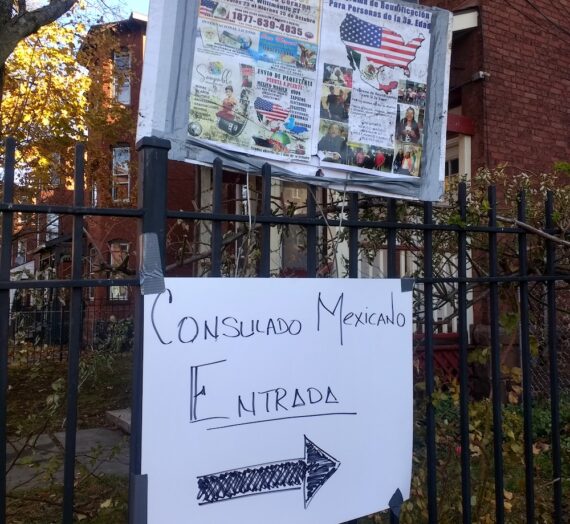 On June 10th, the Licenses and Inspections Division of the Hartford Department of Development Services should have answers.
On June 10th, the Licenses and Inspections Division of the Hartford Department of Development Services should have answers.
At the May 27th Frog Hollow NRZ meeting, Building Official Michael Fuschi gave a presentation on the structural review and feasibility study of 585 Park Street (parcel 226-537-068) — the remaining part of the Lyric Theater. On March 27th, the main section of the theater — 856 Broad Street– was demolished. In the presentation, Fuschi shared a letter from Hallisey Engineering Associates. There were some inaccuracies in the letter: “This building is a three-story structure with a basement that was built in approximately 1900 based upon City records” and “Based on [conversations with Fuschi], the structure has been uninhabited for at least several years and possibly up to 15 years.” From the grand scheme of things, yes, the building was constructed around the 1900’s, but it’s more accurate to say that it was built in approximately 1920. Besides this, the building has been uninhabited for much longer than 15 years. It was destroyed by fire in 1979. It has been demolished by neglect for a time period of thirty years; it was acquired by the Hartford Redevelopment Agency about fifteen years ago. Not attending to such details raises questions about the accuracy of content in the letter.
Based on the letter, the fate of the remaining structure does not look promising. A “significant mold infestation” due to “water infiltration over the years” was noted, as was the potential presence of asbestos (not likely) and lead (very likely). A “significant breach of the roof system” was found, which is not surprising, as the building languished in disrepair for so long. The letter reports: “based on our experience, it is our opinion that the roof breach has significantly reduced the capacity of the structure. Although we cannot say with certainty that the structure will collapse, there is a danger that it could collapse in the near future due to the reduced capacity of the bearing walls and overloading the floor framing.” This sounds uncertain, and reflects poorly on the City of Hartford for ignoring the condition of the building for as long as it did.
There’s more. Hallisey reports that “the exterior bearing walls are beginning to show signs of deterioration where the mortar is popping out of the brick joints. We could not make a determination whether the brick bearing walls are leaning, which would typically indicate a loss of lateral support. […] The wood is waterlogged and the steel is badly corroded from excess exposure to moisture. […] It is our recommendation that the entire interior building be gutted, saving the exterior brick masonry walls to determine their quality and capacity.”
When pressured at the NRZ meeting about when they would complete and provide the results of mortar strength testing to determine stability of exterior building walls, Fuschi said “two weeks.” His deadline is this Thursday, June 10th. Members of the NRZ will be attempting to contact him to see if the City is meeting its responsibilities.
As for others who need to fulfill their promises, Councilperson Cotto had previously stated that he would establish a fund for saving the Lyric Theater. Tomorrow, Wednesday June 9th, Cotto will be devising a resolution calling for the creation of a sub-account.
After reading through the Hallisey letter, my sense was that the only interest the City has is turning this building into another parking lot. For selective demolition (gutting the interior) to occur, $440,000 needs to be found. Of that, $20,000 would be needed just to complete an asbestos/hazardous material survey. This seems outlandishly expensive; however, if the option is to keep the facade and construct an entirely new building with 10,000 square footage, the price tag to rebuild is in the $2,500,000 to $3,500,000 range, plus “professional fees” of another $300,000-400,000. To rehab what is there, the City needs to come up with $440,000. There is $800,000 in the Capitol Improvement Projects budget for the 2011-2012 fiscal year.
There is neighborhood interest in maintaining the building on Park Street, possibly for an arts center or expansion of a library branch. Retail and housing have not been ruled out. Unlike Downtown — which has a dismal 43% retail vacancy rate — the Park Street retail vacancy rate is only at 9.6%. Maintaining the vibrancy of the street is a priority; having a large vacant lot in the heart of the neighborhood would disrupt the continuity of Park Street.

Karma
I think we should all be wary about letting a developer rush in and gut the building lest we forget the boondoggle that was the 2nd district school project. As much of the interior structure as is possible should be saved as it will help stabilize the building. It appears these developers would rather rip the heart of the building out and build anew. Perhaps rather, it is time to find developers with good backgrounds in working with rehabbing historic structures.
Karma
There are also a number of tax credits available for the redevelopment of historic structures. These should be sought out to the fullest as they will make proper preservation of the structure more feasible.
Kerri Provost
Thanks for your input on this. Maybe the right people will read it.
Real Hartford » Resolution for Lyric Theater
[…] After yesterday’s update on the Lyric Theater, Councilperson Cotto provided me with a draft of the resolution which will be submitted to the City Council today. The language of it is as follows: […]